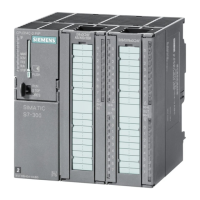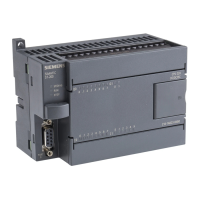Program instructions
7.17 Timer
S7-200 SMART
338 System Manual, 09/2015, A5E03822230-AC
The meaning of the T number depends on the context in your program.
● "T37" assigned to a timer box identifies which timer is to use.
● "T37" assigned to normally open contacts addresses the Boolean T37 timer bit.
● "T37" assigned to integer operations addresses the T37 current time value, as a data
word.
The 1-ms timers count the number of 1-ms timer intervals that have elapsed since the active
1-ms timer was enabled. The execution of the timer instruction starts the timing; however,
the 1-ms timers are updated (timer bit and timer current) every millisecond asynchronous to
the scan cycle. In other words, the timer bit and timer current are updated multiple times
throughout any scan that is greater than 1 ms.
The timer instruction is used to turn the timer on, reset the timer, or, in the TONR timer, to
turn the timer off.
Since the timer can be started anywhere within a millisecond, the preset must be set to one
time interval greater than the minimum desired timer interval. For example, to guarantee a
timed interval of at least 56 ms using a 1-ms timer, the preset time value should be set to 57.
10-millisecond resolution
The 10-ms timers count the number of 10-ms timer intervals that have elapsed since the
active 10-ms timer was enabled. The execution of the timer instruction starts the timing;
however the 10-ms timers are updated at the beginning of each scan cycle (in other words,
the timer current and timer bit remain constant throughout the scan), by adding the
accumulated number of 10-ms intervals (since the beginning of the previous scan) to the
current value for the active timer.
Since the timer can be started anywhere within a 10-ms interval, the preset must be set to
one time interval greater than the minimum desired timer interval. For example, to guarantee
a timed interval of at least 140 ms using a 10-ms timer, the preset time value should be set
to 15.
100-millisecond resolution
The 100-ms timers count the number of 100-ms timer intervals that have elapsed since the
active 100-ms timer was last updated. These timers are updated by adding the accumulated
number of 100-ms intervals (since the previous scan cycle) to the timer’s current value when
the timer instruction is executed.
The current value of a 100-ms timer is updated only if the timer instruction is executed.
Consequently, if a 100-ms timer is enabled but the timer instruction is not executed each
scan cycle, the current value for that timer is not updated and it loses time. Likewise, if the
same 100-ms timer instruction is executed multiple times in a single scan cycle, the number
of 100-ms intervals is added to the timer’s current value multiple times, and it gains time.
100-ms timers should only be used where the timer instruction is executed exactly once per
scan cycle.

